In the heart of Japan’s storied landscapes lies a rhythmic dance of seasons and climates, each offering a unique invitation to explore and revel in the wonders of this remarkable country. Among these, two distinct periods emerge as the best time to visit Japan for ideal weather, presenting travelers with a splendid embrace of ideal conditions to pursue experiences in comfort.
Beneath the delicacy of spring and the resilience of autumn, Japan reveals its essence in all of its glory. The most comfortable conditions present themselves as the winds of spring whisper through the cherry blossoms and again when autumn sets ablaze a tapestry of foliage. This is the Japan that beckons to those who seek the convergence of ideal weather, predominately safe conditions, and connection with this country’s captivating landscapes and cultural heritage.
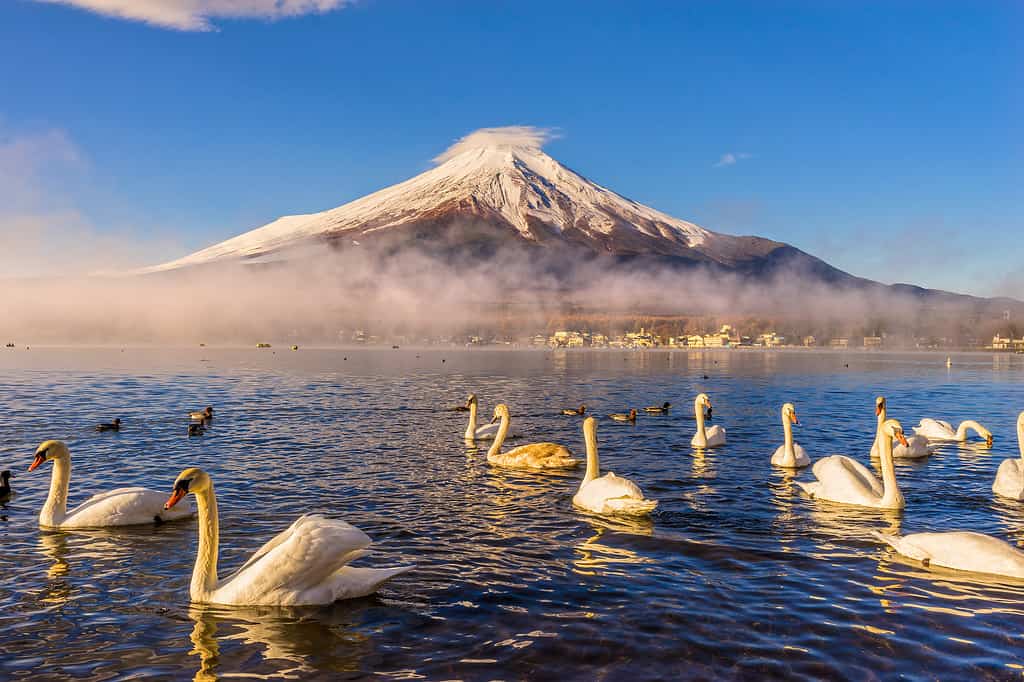
Japan is a hotspot for tourism due to its incredible natural landscapes, impressive cities, and fascinating culture. It experiences four separate seasons.
©Luciano Mortula/iStock via Getty Images
What Is the Best Time of Year to Visit Japan for Ideal Weather?
Japan is a land filled with cultural richness and natural enchantment. It has diverse landscapes, expansive cityscapes, historical treasures, spiritual wonders, and a harmonious blend of tradition and modernity within its culture. When it comes to the best time to visit Japan, weather is one of the most significant factors when planning your visit to this captivating country, and timing plays a crucial role. The best time to visit Japan is between March through April and October through November, when the weather is ideal. These timeframes offer pleasant temperatures, moderate precipitation, and a reduced likelihood of natural disasters.
It is worth noting that Japan has four separate seasons. However, its climate ranges from subtropical in the south to subarctic in the north. Northern Japan, the Sea of Japan side of Japan, and mountainous regions all experience hot summers and frigid winters with heavy snowfall. Overall, climate and weather conditions vary between the Pacific side of Japan and the Sea of Japan side of Japan as well.
Temperature and Climate
From March to April and October to November, Japan experiences some of its most comfortable weather conditions. The average temperatures vary across different regions of the country. Yet, they generally fall within a range that is appealing to visitors seeking comfortable outdoor experiences.
In spring (March to April), the temperatures begin to warm up after the cold winter months. Cherry blossoms, a beloved cultural icon of Japan, typically bloom during this period. The temperatures across the country range from approximately 10 to 20 degrees Celsius (50 to 68 degrees Fahrenheit), creating an atmosphere conducive to exploration without the extremes of heat or cold.
As autumn (October to November) takes its place, Japan undergoes a mesmerizing transformation as foliage bursts into vibrant shades of red, orange, and gold. During this season, the temperatures again vary depending on the region but generally hover around 13 to 23 degrees Celsius (55 to 73 degrees Fahrenheit), providing an excellent climate for sightseeing and outdoor activities.
Overall, the spring and autumn timeframes experience the mildest temperatures without the excessive humidity that accompanies the summer months, which average 30 degrees Celsius (85 degrees Fahrenheit) paired with incredible humidity. In contrast, the winter months experience the coldest temperatures, averaging 7 degrees Celsius (45 degrees Fahrenheit).
Precipitation Patterns
The precipitation patterns during the recommended months for visiting Japan also contribute to the overall appeal of these seasons. In both spring and autumn, rainfall is relatively moderate, allowing travelers to enjoy the country’s natural beauty without the hindrance of heavy downpours.
The average rainfall varies across different regions during spring (March to April). While some areas experience slightly higher precipitation, the overall rainfall remains moderately low, averaging approximately 8 days of rain per month, with April experiencing marginally more rainfall than March. This creates an environment where cherry blossoms flourish and lush landscapes come to life. Spring also experiences some of the sunniest days per month.
In autumn (October to November), the rainfall remains relatively consistent with the spring months, averaging approximately 8 days per month. Moreover, October tends to harbor slightly more rain than November. As precipitation dissipates with winter approaching, it supports the picturesque transformation of trees into a stunning medley of warm, vivid colors of exuberant orange, gold, and red hues, enhancing the allure of Japan’s natural landscapes and foliage.
The spring and fall timeframes are ideal when considering precipitation and temperature. While winter experiences the least amount of precipitation, it also comes with the coldest temperatures. In contrast, the summer months host the rainy season, experiencing an average of approximately 12 days of heavy rain or more per month accompanied by intense humidity.
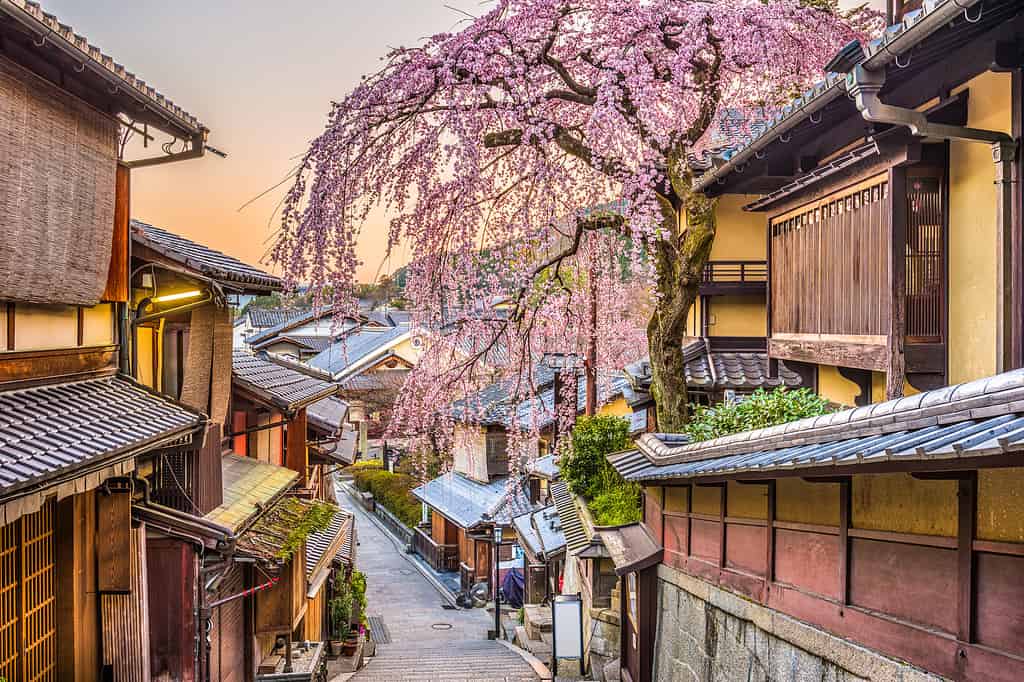
Japan is a land filled with cultural richness and natural enchantment. The diverse landscapes and expansive cityscapes of Japan are filled with historical treasures, spiritual wonders, and cultural experiences. The best time to visit Japan is arguably between March through April and October through November. This is when the weather is ideal, and the temperatures are pleasant.
©Sean Pavone/iStock via Getty Images
Natural Disasters
Understanding the potential risks is an integral part of travel planning. Fortunately, the months of March to April and October to November in Japan are characterized by a reduced likelihood of major natural disasters. On the whole, Japan experiences various natural disasters throughout the year, including earthquakes, tsunamis, volcanic activity, landslides, floods, typhoons, and even wildfires.
Earthquakes and volcanic activity are likely the most common natural disasters experienced in Japan as they occur consistently. Yet, their intensity is completely randomized throughout the year. This is due to Japan’s volcano population and location on four tectonic plates, which include the Pacific, Philippine Sea, North America (or Okhotsk), and Eurasia (or Amur). Moreover, Japan is located on the Ring of Fire, which is a region around the Pacific Ocean where many volcanic activity and earthquakes occur. The country is home to approximately 10% of the world’s volcanos, many of which are active.
In addition, more than 1,500 earthquakes are experienced in the country each year. Thankfully, the majority of these earthquakes are quite small, measuring between 3.0 and 3.9 on the Richter scale. And thus, the majority go unnoticed by people. However, over 100 earthquakes measure above 5 on the Richter scale each year and can cause significant damage and danger to human life.
Furthermore, tsunamis are often a result of underwater tectonic activity, as a result of volcanic activity or earthquakes. They can strike with little warning and devastate coastal communities and landscapes. Tsunamis occur primarily in the Pacific Ocean and hit Japan at least once a year. Earthquakes that measure 7 or more on the Richter scale can generate tsunamis.
Spring
The typhoon season is yet to begin in spring, sparing travelers from the intense weather conditions and heavy rainfall associated with these tropical storms. Typhoons and hurricanes are similar natural phenomena. They are both tropical cyclones. The difference between the two is where the tropical cyclone takes place. Tropical cyclones in the Northwest Pacific Ocean are called typhoons. In contrast, tropical cyclones in the North Atlantic, central North Pacific, or eastern North Pacific oceans are hurricanes. Typhoon season in Japan extends from May to October, and July through September is the peak season. Typhoons experienced later in the season tend to be stronger than those that occur earlier in the season. Across the prime times to travel to Japan, March through April and October through November, it is unlikely to experience typhoon activity.
Summer
During the summer months, which is not the ideal time to travel to Japan due to weather, floods and landslides are common occurrences. This is a result of the rainy season, which peaks in June and July. Intense flooding can destabilize the land, which in turn causes landslides.
Autumn
During autumn, the typhoon season winds down, resulting in a lower possibility of encountering these stormy events and making October and November a suitably safe window for pleasant weather while visiting Japan.
Winter
Finally, during the winter season, wildfires are a considerable concern. This is due to the dry conditions and little precipitation. Thankfully, you aren’t likely to experience wildfire activity if you visit Japan during the best time for ideal weather, between March through April and October through November.
Overall, the months of March through April and October through November emerge as the most favorable periods to explore Japan and seek unique experiences. With comfortable temperatures, moderate precipitation, and a reduced likelihood of natural disasters, these seasons provide an ideal canvas for an unforgettable journey through the heart of this captivating nation.

When considering natural disasters, typhoon season is predictable but intense and potentially dangerous.
©Sean Pavone/Shutterstock.com
What Time of Year Experiences the Worst Weather in Japan?
Japan boasts an intricate tapestry of weather patterns that change dramatically throughout the year. From the tranquil cherry blossoms of spring to the dynamic foliage of autumn, each season brings its unique weather characteristics. While we know the best time to visit Japan for ideal weather, what are the worst times to visit Japan due to bad weather?
Seasons and Weather Extremes in Japan
While Japan’s overall weather is generally temperate, some times of the year stand out for challenging weather conditions. From summer to early autumn, typically from May to October, Japan faces the fury of tropical storms or typhoons. These robust weather systems, akin to hurricanes, bring heavy rainfall, strong winds, and the risk of flooding and landslides. The typhoon season casts a shadow of uncertainty over the affected regions, impacting travel plans, daily life, and infrastructure.
Hottest and Coldest Times of the Year in Japan
Japan experiences distinct temperature fluctuations, with the hottest and coldest times of the year contrasting sharply. The summer months, specifically July, August, and September, mark the zenith of heat across the country. Average temperatures during this humid period range from 25 to 35 degrees Celsius (77 to 95 degrees Fahrenheit), sometimes even soaring higher in certain regions. The humidity during these months can be particularly stifling, making outdoor activities uncomfortable and necessitating precautions to avoid heat-related illnesses.
Conversely, the coldest period spans from December to February, with January being the peak of winter’s frigid embrace. The temperatures drop significantly, dipping as low as -10 to 10 degrees Celsius (14 to 50 degrees Fahrenheit). In the northern regions of Hokkaido, snow blankets the landscape, creating a picturesque winter wonderland with some of the coldest temperatures. During this time, the warmth of winter clothing becomes necessary, and the allure of hot springs and steaming bowls of comfort food beckons.
Season of Heaviest Precipitation in Japan
Considering the heaviest season of precipitation, the early summer months of June and July take the spotlight as the period of heaviest rainfall in Japan. It is characterized by prolonged and intense downpours. The southwest monsoon brings moist air from the Pacific Ocean, colliding with cooler air over Japan’s landmass, resulting in a deluge of rain and humidity. This season is crucial for replenishing water sources and sustaining agriculture. However, it also presents challenges such as localized flooding and landslides.
Overall, Japan’s climatic diversity is an intricate interplay between geography and atmospheric conditions. From the tempestuous typhoon season to the contrasting extremities of the hottest and coldest temperatures and the deluge of the rainy season, each period holds its challenges. Understanding these seasonal variations is vital not only for travelers seeking an immersive experience but also for residents navigating the ebb and flow of their home’s weather patterns.
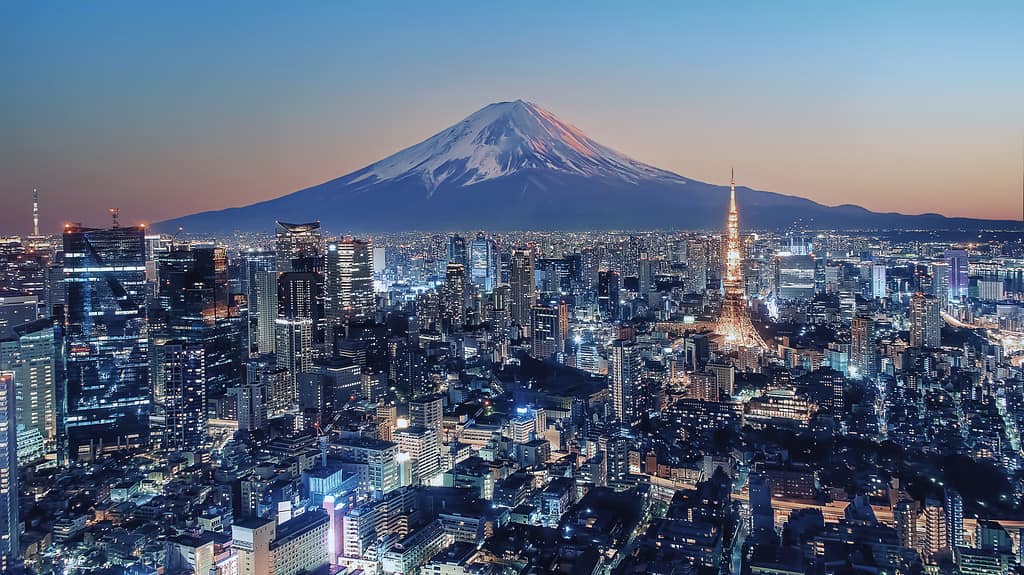
Depending on the location, Japan can experience temperatures ranging from frigid temperatures of -10 degrees Celsius and humid temperatures upwards of 35 degrees Celsius (14 to 95 degrees Fahrenheit).
©StockByM/iStock via Getty Images
The Best Time of Year to Visit Japan to Avoid Heavy Tourism
While the allure of Japan draws visitors year-round, there are periods when the throngs of tourists recede. This allows for a more intimate connection with Japan’s natural beauty and culture. Discerning travelers eager to escape the crowds would do well to consider two distinctive seasons that promise serenity and a deeper immersion into the essence of Japan. Coincidently, both seasons fall within close alignment with the best times to visit Japan for ideal weather.
Spring
As spring unfurls its vibrant tapestry across Japan, a window of opportunity exists to explore without the influx of heavy tourism. Early March trickling into April is a prime time to visit Japan before the influx of tourism picks up. During this period, the weather is starting to warm up from the winter chill. It is accompanied by sunny days, cool temperatures, and less precipitation. The cherry blossoms are beginning to bloom with intensity. And an array of foliage and blooming flowers imbue the landscapes with a renewed vibrancy.
This period allows travelers to relish outdoor activities, cultural explorations, and unhurried moments at historically significant sites. The reduced tourist footfall ensures a more personalized experience, where interactions with locals and the immersion into authentic traditions become seamless. Additionally, accommodation and transportation options are more readily available, contributing to a seamless and peaceful journey.
Autumn
As the fiery hues of autumn foliage paint Japan’s landscapes in a symphony of reds, oranges, and golds, another season of tranquility emerges. Late November is another pocket of time that can provide a respite from the crowds. The comfortable temperatures and less precipitation also offer a comfortable environment.
This period follows the peak of autumn tourism. The crowds that flocked to witness the stunning fall foliage begin to dwindle. The vibrant colors persist, offering a backdrop that complements the quieter ambiance. Cultural sites, such as temples and historic towns, beckon with an air of intimacy. They allow travelers to delve deeper into the soul of Japan. The slower pace also presents opportunities for engaging with local communities and savoring the seasonal delicacies that epitomize Japanese cuisine.
Summer and Winter
If you don’t mind intense weather, you can also find moments of respite from crowds in the heat of summer or the chill of winter. Periods between June and July can be some of the cheapest because of fewer crowds. This is due to the peak of the rainy season. In contrast, the freezing temperatures of the dry winter season, mainly in January, can also result in less tourist traffic.
Within each season in Japan, there are windows of tranquility and escape from heavy tourism. The late spring and late autumn months stand as gateways to a more personal connection with the best weather conditions. Moreover, the months of summer and winter offer pockets of time with fewer crowds but come with intense weather conditions. Travelers who embrace any of these short-lived periods are rewarded with unhurried explorations, meaningful encounters, and a deeper understanding of the nuances that define Japan’s essence.
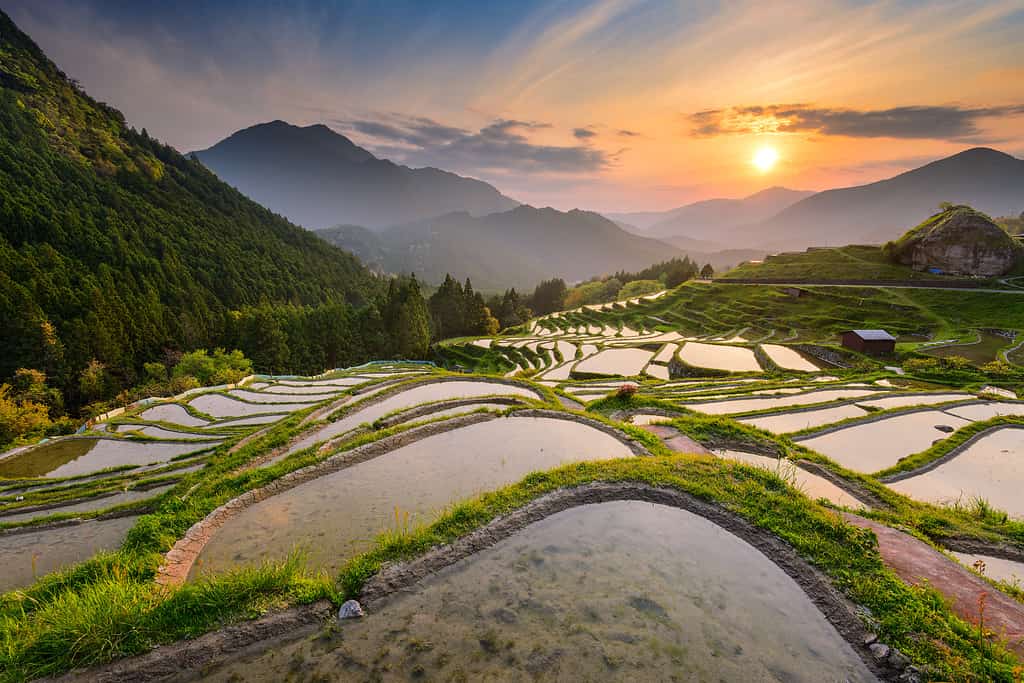
Japan is home to incredibly diverse landscapes. From mountains and meadows to farmlands and coastlines and massive cities to secluded villages, Japan is bursting with culture and natural beauty.
©SeanPavonePhoto/iStock via Getty Images
Conclusion
In Japan, tradition meets modernity amidst diverse landscapes. The quest for the best time to visit Japan for ideal weather is a voyage of discovery itself. As the seasons change, two distinctive periods stand out to travelers with the promise of optimal weather and immersive experiences. March through April and October through November stand as Japan’s most comfortable timeframes to visit for the best weather. They offer a harmonious blend of comfort, natural splendor, and cultural allure.
During the spring embrace of March through April, cherry blossoms paint the canvas with delicate hues. Temperatures ranging from 10 to 20 degrees Celsius (50 to 68 degrees Fahrenheit) provide a gentle backdrop for exploration. As autumn ushers in the tapestry of October through November, foliage transforms into a symphony of warm tones. Temperatures of 13 to 23 degrees Celsius (55 to 73 degrees Fahrenheit) invite travelers to bask in comfort.
Amidst the vibrancy of this country, sources such as the Japan Meteorological Agency and the Japan National Tourism Organization provide plentiful information to help plan your visit to Japan with confidence and clarity.
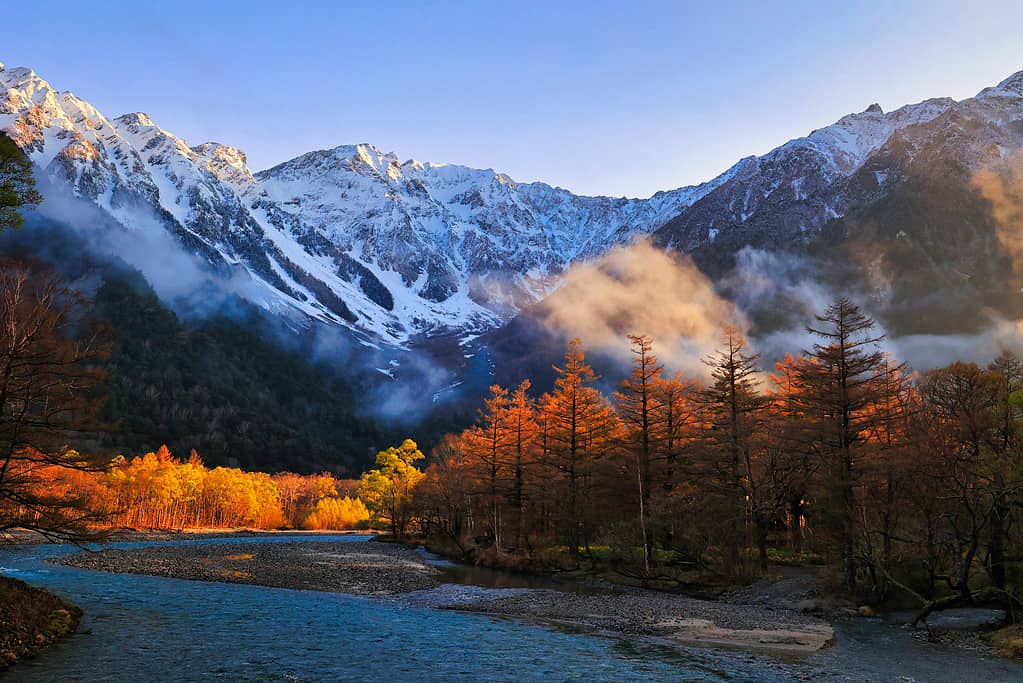
Japan is a year-round destination and a popular country for tourism. However, there are pockets throughout the year that offer a respite from the crowds of tourists.
©Taka Mountain Gallery/ via Getty Images
The photo featured at the top of this post is © Sean Pavone/iStock via Getty Images
Thank you for reading! Have some feedback for us? Contact the AZ Animals editorial team.







